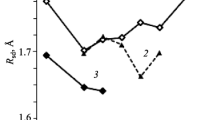Abstract
The most important characteristics of the Voronoi-Dirichlet polyhedra (VDP) were determined for the 146 493 crystallographically different A atoms (A = Rb, Sr, Y, Zr, Nb, Mo, Tc, Ru, Rh, Pd, Ag, Cd, In, Sn, Sb, Te, I, or Xe) in sublattices containing chemically identical atoms in the crystal structures of 82093 inorganic and organoelement compounds. Irrespective of the nature of the element of period 5, the VDP have most often 14 faces, the Fedorov cuboctahedron being the most abundant VDP type. The metal atoms A were found to have, most often, C 1 site symmetry (79% of cases) and also C s, C 2, and C i site symmetries (7 to 2%). Certain relationships were shown to exist between the nature of the metal atom and the preferred symmetry of the site it occupies in the crystal structure.
Similar content being viewed by others
References
Serezhkin, V.N., Pushkin, D.V., and Serezhkina, L.B., Koord. Khim., 2006, vol. 32, no. 11.
Parthe, E., Elementos de Quimica Inorganica Estructural, 1992.
Aslanov, L.A., Struktury veshchestv (Structures of Substances), Moscow: Mosk. Gos. Univ., 1989.
Sovremennaya kristallografiya v chetyrekh tomakh (Modern Crystallography in Four Volumes), Vainshtein, B.K., Fridkin, V.M., and Indenbom, V.L., Eds., Moscow: Nauka, 1979, vol. 2.
Wells, A.K., Structural Inorganic Chemistry, Oxford: Clarendon, 1986.
Pearson, W.B., The Crystal Chemistry and Physics of Metals and Alloys, New York: Wiley, 1972.
O’Keeffe, M. and Hyde, B.G., Structure and Bonding, Berlin: Springer, 1985, vol. 61, p. 77.
Borisov, S.V. and Podberezskaya, N.V., Stabil’nye kationnye karkasy v strukturakh ftoridov i oksidov (Stable Cationic Frameworks in Structures of Fluorides and Oxides), Novosibirsk: Nauka, 1984.
Borisov, S.V., Kristallografiya, 2000, vol. 45, no. 5, p. 779 [Crystallogr. Rep. (Engl. Transl.), vol. 45, no. 5, p. 709].
Vegas, A., Crystallogr. Rev., 2000, vol. 7, p. 189.
Vegas, A. and Jansen, M., Acta Crystallogr., Sect. B: Struct. Sci., 2002, vol. 58, no. 1, p. 38.
Inorganic Crystal Structure Database, Gmelin Istitut Fur Anorganische Chemie & FIC, Karlsruhe, 2004.
Cambridge Structural Database System. Release 2004, Cambridge: Crystallographic Data Centre, 2004.
Blatov, V.A., Shevchenko, A.P., and Serezhkin, V.N., Koord. Khim., 1999, vol. 25, no. 7, p. 483.
Hoppe, R. and Kohler, J., Z. Kristallogr., 1988, vol. 183, no. 1, p. 77.
Author information
Authors and Affiliations
Additional information
Original Russian Text © V.N. Serezhkin, D.V. Pushkin, L.B. Serezhkina, 2006, published in Koordinatsionnaya Khimiya, 2006, Vol. 32, No. 12, pp. 906–915.
Rights and permissions
About this article
Cite this article
Serezhkin, V.N., Pushkin, D.V. & Serezhkina, L.B. Maximum filling principle and sublattice characteristics for the atoms of period V elements. Russ J Coord Chem 32, 869–878 (2006). https://doi.org/10.1134/S1070328406120037
Received:
Issue Date:
DOI: https://doi.org/10.1134/S1070328406120037




